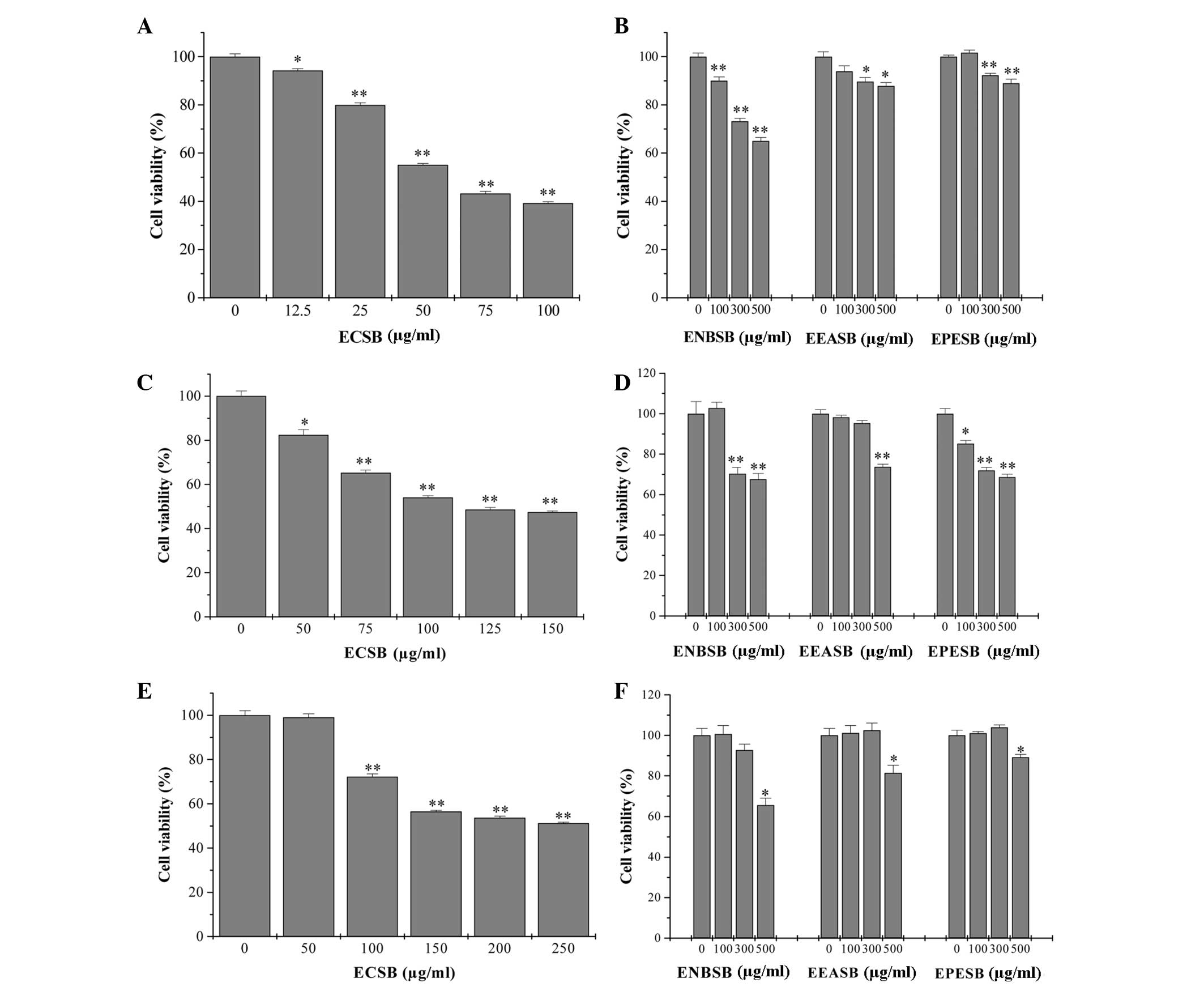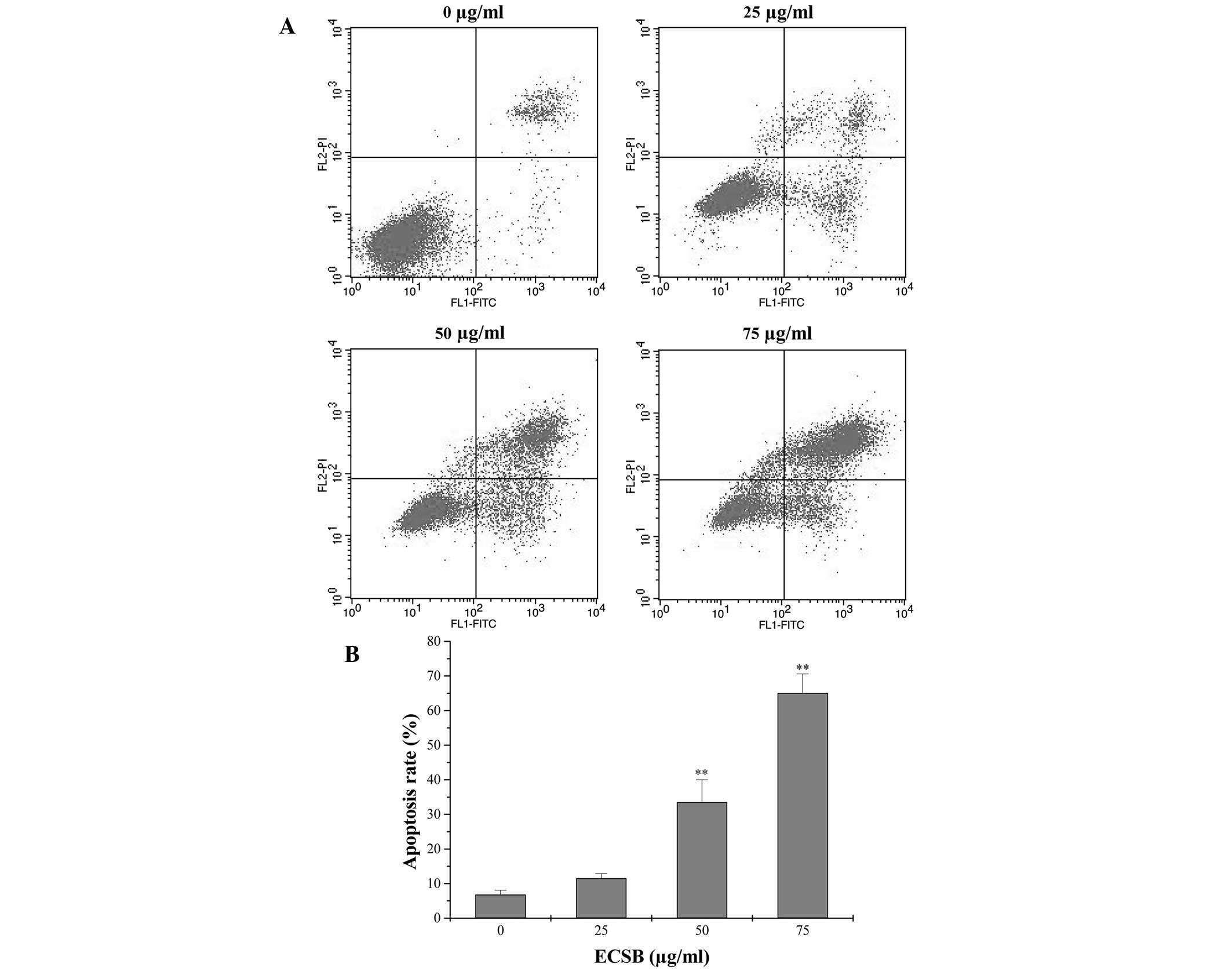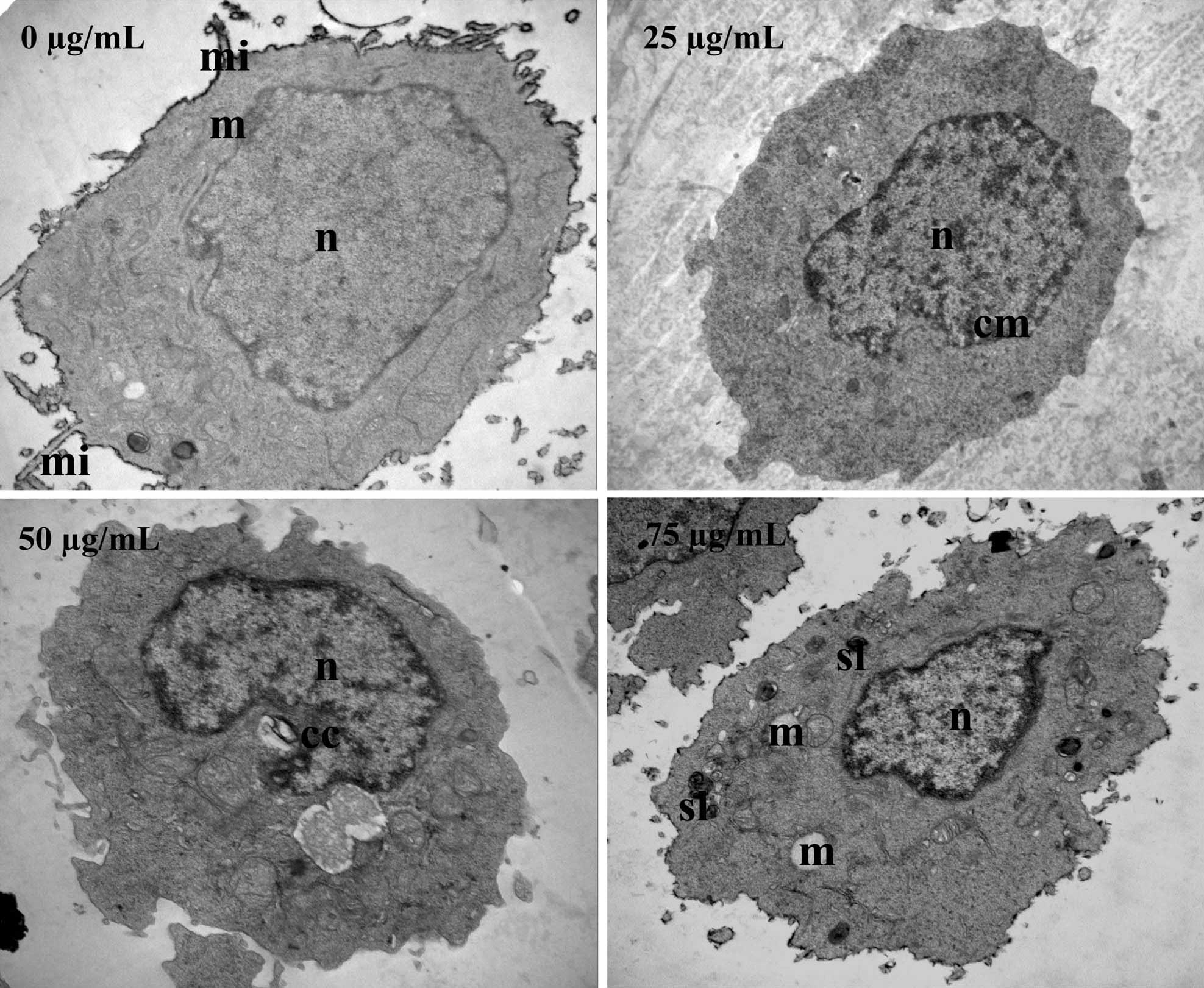Chloroform fraction of Scutellaria barbata D. Don promotes apoptosis and suppresses proliferation in human colon cancer cells
- Authors:
- Published online on: December 16, 2013 https://doi.org/10.3892/mmr.2013.1864
- Pages: 701-706
Abstract
Introduction
Colorectal cancer (CRC) is one of the most serious malignancies with its incidence and mortality increasing annually (1). Although surgical resection offers the greatest prognosis, a substantial portion of CRC patients already present with metastatic disease at the time of diagnosis (2,3). Additionally, surgery is not always able to extirpate the recurrence of advanced CRC (4). Therefore, chemotherapy remains one of the major non-surgical therapeutic approaches for patients with advanced CRC. However, the efficacy and safety of the chemotherapies which are currently used remains a challenge due to severe toxicity, multidrug resistance and other side effects (5–7). Faced with these major problems, the development of novel anticancer agents is urgently required. Traditional Chinese medicine (TCM), dating back thousands of years, is important in the treatment of various diseases, including cancer (8–10). Clinical practice has also demonstrated that numerous TCMs are effective for the treatment of CRC (11).
Scutellaria barbata D. Don (SB) is a medicinal herb widely distributed in northeast Asia. As a well known traditional Chinese folk medicine, it has long been used to clinically treat various types of cancer (12–16). In particular, our previous studies demonstrated that the extracts of SB were able to suppress colon cancer growth in vivo and in vitro, possibly by inducing cancer cell apoptosis and inhibiting cell proliferation and tumor angiogenesis (16–18). However, the anticancer mechanisms of its bioactive ingredients are largely unclear. In the present study, using three human colon cancer cell lines SW620, HT-29 and HCT-8, the antitumor effect of different polar fractions of SB were evaluated and the potential underlying molecular mechanisms were investigated. It was revealed that the chloroform fraction of SB (ECSB) exhibited the most potent inhibitory effect on the growth of all three colon cancer cell lines and SW620 cells exhibited the most sensitive response to ECSB treatment. In addition, ECSB promoted apoptosis via the upregulation of the pro-apoptotic Bax/Bcl-2 ratio and inhibited proliferation by suppressing the expression of the pro-proliferative cyclin D1 and cyclin-dependent kinase 4 (CDK4) in SW620 cells.
Materials and methods
Materials and reagents
RPMI-1640 medium, KGML-15 SY medium, fetal bovine serum (FBS), penicillin-streptomycin and trypsin-EDTA were obtained from Hyclone (Carlsbad, CA, USA). TRIzol reagent and SuperScript II reverse transcriptase were purchased from Invitrogen Life Technologies (Grand Island, NY, USA). Anti-Bcl-2, Bax, Cyclin D1, CDK4 and β-actin antibodies, and horseradish peroxidase (HRP)-conjugated secondary antibodies were obtained from Cell Signaling Technology (Beverly, MA, USA). A fluorescein isothiocyanate (FITC)-conjugated Annexin V apoptosis detection kit was provided by Becton-Dickinson (San Jose, CA, USA). All the other chemicals, unless otherwise stated, were obtained from Sigma-Aldrich (St. Louis, MO, USA).
Preparation of the SB extract
The herb was obtained from the Guo Yi Tang Chinese Herbal medicine store (Fujian, China). SB (500 g) was extracted three times with 5,000 ml of 85% ethanol using a refluxing method and filtered. The solvent was fractionated by a series of solvents, including petroleum ether, chloroform, ethyl acetate and N-butanol, to obtain the petroleum ether fraction of SB (EPESB), ECSB, ethyl acetate fraction of SB (EEASB) and the N-butanol fraction of SB (ENBSB). These fractions were then evaporated on a rotary evaporator. They were all dissolved in 100% dimethylsulfoxide (DMSO) to a stock concentration of 200 mg/ml and stored at −20°C. The final concentration of DMSO in the medium for all the experiments was ≤0.25%.
Cell culture
Human carcinoma SW620, HT-29 and HCT-8 cells were obtained from the Cell Bank of the Chinese Academy of Sciences (Shanghai, China). SW620 cells were grown in L-15 medium and HT-29 and HCT-8 cells were cultured in RPMI-1640 medium, supplemented with 10% fetal bovine serum, 100 U/ml penicillin and 100 mg/ml streptomycin at 37°C in 5% CO2 humidified air.
Cell viability using an 3-(4, 5-dimethylthiazol-2-yl)-2,5-diphenyltetrazolium bromide (MTT) assay
Cell viability was assessed by an MTT colorimetric assay. SW620, HT-29 and HCT-8 cells were seeded into 96-well plates at a density of 5×105, 3×105 and 1×105 cells/ml in 100 μl of medium, respectively. The cells were treated with serial concentrations of fractions of SB for 24 h. Following treatment, 100 μl of MTT (0.5 mg/ml in PBS) was added to each well and the cells were incubated at 37°C for 4 h. The medium was removed and the purple-blue MTT formazan precipitate was dissolved in 100 μl of DMSO. The absorbance was measured at 570 nm using an ELISA reader (model ELX800; BioTek, Winooski, VT, USA). The cell viability was determined using the formula: Cell viability (%) = sample optical density (OD)/control OD × 100.
Detection of apoptosis by flow cytometric analysis with Annexin V/propidium iodide (PI) staining
Following starvation for 12 h, SW620 cells were incubated for 24 h in various concentrations of ECSB. Apoptosis of SW620 cells was determined by flow cytometric analysis using a fluorescence-activated cell sorting (FACS) caliber (Becton-Dickinson) and an Annexin V-FITC/PI kit (Becton-Dickinson). The procedure was performed according to the manufacturer’s instructions. Annexin V-positivity and PI-negativity indicated the presence of early apoptotic cells, while Annexin V-positivity and PI-positivity indicated the presence of late apoptotic cells.
Observation of ultrastructural characteristics by transmission electron microscopy (TEM)
Cells were fixed with 1.5% paraformaldehyde and 3% glutaraldehyde in 0.1 mol/l sodium cacodylate buffer (pH 7.2–7.4) at 4°C for 24 h. The cell suspensions were then rinsed twice with phosphate-buffered saline (PBS) and post-fixed with 1% osmic acid in 0.1 mol/l sodium cacodylate buffer for 2 h. The cells were dehydrated in a graded series of alcohol and embedded with epoxy resin 618. Ultrathin sections (80 nm) were mounted on the copper wire mesh grids, air-dried, stained with 2.0% uranyl acetate for 15 min and counterstained with lead citrate for 15 min. The sections were examined and images were captured using a Hitachi 7650 electron microscope (Tokyo, Japan).
Colony formation
SW620 cells were seeded into 6-well plates at a density of 5×105 cells/ml in 2 ml medium. Following treatment with various concentrations of ECSB for 48 h, cells were harvested and diluted in 2 ml fresh medium without ECSB, and then each well was reseeded at a density of 1,000 cells per well. The medium was replaced with fresh medium every three days. Following 14 days, cells were fixed with 10% formaldehyde, stained with 0.01% crystal violet and counted. The cell survival rate was calculated by normalizing the survival rate of the control cells to 100%.
Reverse transcription-polymerase chain reaction (RT-PCR) analysis
SW620 cells were exposed to various concentrations of ECSB for 48 h and then total RNA was isolated with TRIzol reagent (Invitrogen Life Technologies). First-strand cDNA was generated via reverse transcription of 2 μg total RNA using Oligo(dT) primer and SuperScript II reverse transcriptase according to the manufacturer’s instructions. The obtained cDNA was used to determine the mRNA levels of Bax, Bcl-2, Cyclin D1 and CDK4 by PCR with TaqDNA polymerase (Fermentas, Vilnius, Lithuania). GAPDH was used as an internal control.
Western blot analysis
SW620 cells were treated with various concentrations of ECSB for 48 h. Adherent and floating cells were harvested and rinsed three times with PBS buffer. The cells were lysed with radioimmunoprecipitation assay lysis buffer (Pierce Chemical Co., Rockford, Illinois, USA) containing phenylmethanesulfonyl fluoride and extracts were quantified using the bicinchoninic acid protein assay (Pierce Chemical Co.) The proteins (30 μg) were separated by 12% SDS-PAGE gels and transferred onto polyvinylidene fluoride membranes (Millipore Corporation, Billerica, MA, USA). The membranes were inhibited with 5% skimmed milk and probed with primary antibodies against Bax, Bcl-2, cyclin D1, CDK4 and β-actin (1:1,000) overnight at 4°C. The membranes were rinsed three times with Tris-buffered saline with Tween-20 (TBST) and then the appropriate HRP-conjugated secondary antibodies were diluted at 1:5,000 in blocking solutions for 1 h at room temperature. Following washing again in TBST, the membranes were detected by enhanced chemiluminescence. β-actin was used as an internal control.
Statistical analysis
Data were analyzed using the SPSS package for Windows (version 13.0; SPSS Inc., Chicago, IL, USA). The quantitative data are expressed as the mean ± standard deviation. Statistical analysis of the data was performed using Student’s t-test. P<0.05 was considered to indicate a statistically significant difference.
Results and Discussion
ECSB exhibits the most potent inhibitory effect on the growth of colon cancer cells
By performing an MTT assay in three human colon cancer cell lines, SW620, HT-29 and HCT-8, the in vitro anticancer effect of different fractions of SB, including EPESB, ECSB, EEASB and ENSB, was compared. As shown in Fig. 1, all the fractions inhibited the viability of three cancer cells in a dose-dependent manner. In particular, ECSB exhibited the most potent antitumor activity in SW620 cells, with an IC50 of 65 μg/ml. To further examine the mode of action of ECSB, SW620 cells were selected for the following study.
ECSB promotes apoptosis and inhibits the proliferation of SW620 cells
Apoptosis eliminates excess, redundant, abnormal cells in animals and thus is crucial for animal development and tissue homeostasis. Disturbed regulation of this vital process represents a major causative factor in tumorigenesis (19). Therefore, in order to determine the mechanism of the growth suppressive activity of ECSB, its effect on apoptosis in SW620 cells was examined. The in vitro cell apoptosis was assessed via Annexin V/PI staining followed by FACS analysis. As shown in Fig. 2, the percentage of cells undergoing either early apoptosis or late apoptosis following treatment with 0, 25, 50 and 75 μg/ml ECSB was 6.80, 11.54, 33.53 and 65.12%, respectively (P<0.05), suggesting that ECSB treatment significantly induced apoptosis in SW620 cells in a dose-dependent manner.
In order to verify these results, TEM was used to observe ultrastructural changes in SW620 cells following ECSB treatment. As shown in Fig. 3, untreated cells exhibited a normal ultrastructure, including numerous microvilli on the cell surface, evenly distributed chromatin, a large nucleolus in the nucleus and numerous large mitochondria in the cytoplasm. By contrast, following treatment with ECSB, SW620 cells underwent significant ultrastructural changes that represented the typical morphological features of apoptosis, including a low nucleus/cytoplasm ratio, chromatin margination and condensation, formation of vacuoles in the mitochondria, formation of secondary lysosomes, loss of cellular microvilli and mitochondrial cristae. These data further demonstrated the pro-apoptotic activity of ECSB.
Cancer cells are also characterized by uncontrolled proliferation, therefore, inhibiting the excessive proliferation of tumor cells is one of the key approaches for the development of anticancer drugs. In order to determine the effect of ECSB on the proliferation of cancer cells, the survival rate in ECSB-treated SW620 cells was evaluated using a colony formation assay. As shown in Fig. 4, treatment with 25, 50 and 75 μg/ml ECSB for 48 h, respectively, reduced the survival rate of SW620 cells to 93.42, 54.82 and 5.85%, as compared with the untreated control cells (P<0.05), suggesting that ECSB suppressed the proliferation of colon cancer cells in a dose-dependent manner.
ECSB regulated the expression of Bax, Bcl-2, cyclin D1 and CDK4
Bcl-2 family proteins are key regulators of apoptosis, functioning as either suppressors, including Bcl-2, or promoters, including Bax (20). Tissue homeostasis is maintained by controlling the ratio of active anti- and pro-apoptotic Bcl-2 family proteins. A higher Bcl-2/Bax ratio caused by aberrant expression of the proteins is commonly found in various types of cancer, which not only confers a survival advantage to the cancer cells, but also results in drug resistance. Eukaryotic cell proliferation is primarily regulated by the cell cycle. G1/S transition is one of the main checkpoints of the cell cycle and is responsible for the initiation and completion of DNA replication. G1/S progression is regulated by cyclin D1, which exerts its function via forming an active complex with its CDK major catalytic partners (CDK4/6) (21,22). An unchecked or hyperactivated cyclin D1/CDK4 complex often leads to uncontrolled cell division and malignancy (23–25).
In order to further examine the mechanisms of the pro-apoptotic and antiproliferative activities of ECSB, RT-PCR and western blot analysis were performed to examine the expression of Bax, Bcl-2, cyclin D1 and CDK4. As shown in Fig. 5, ECSB significantly reduced the mRNA and protein expression of anti-apoptotic Bcl-2 as well as the pro-proliferative cyclin D1 and CDK4, whereas that of pro-apoptotic Bax was markedly increased following ECSB treatment.
In conclusion, the present study demonstrated that ECSB exhibited a potent inhibitory effect on colon cancer cell growth, which was mediated by its pro-apoptotic and antiproliferative activity. These results provide a strong scientific foundation for the development of novel anticancer agents from the bioactive ingredients in ECSB.
Acknowledgements
This study was supported by the National Natural Science Foundation of China (grant no. 81073097).
Abbreviations:
|
CRC |
colorectal cancer |
|
SB |
Scutellaria barbata D. Don |
|
ECSB |
chloroform fraction of Scutellaria barbata D. Don |
|
EPESB |
petroleum ether fraction of Scutellaria barbata D. Don |
|
EEASB |
ethyl acetate fraction of Scutellaria barbata D. Don |
|
ENSB |
N-butanol fraction of Scutellaria barbata D. Don |
|
TCM |
traditional Chinese medicine |
|
TEM |
transmission electron microscopy |
|
MTT |
3-(4, 5-dimethylthiazol-2-yl)-2,5-diphenyltetrazolium bromide |
References
|
Spiro S: Lung cancer: principles and practice. Br J Cancer. 85:16092001. View Article : Google Scholar | |
|
Bosset JF, Calais G, Mineur L, et al: Enhanced tumorocidal effect of chemotherapy with preoperative radiotherapy for rectal cancer: preliminary results-EORTC 22921. J Clin Oncol. 23:5620–5627. 2005. View Article : Google Scholar : PubMed/NCBI | |
|
Rougier P, Bugat R, Douillard JY, et al: Phase II study of irinotecan in the treatment of advanced colorectal cancer in chemotherapy-naive patients and patients pretreated with fluorouracil-based chemotherapy. J Clin Oncol. 15:251–260. 1997.PubMed/NCBI | |
|
Jiang WQ, Fu FF, Li YX, et al: Molecular biomarkers of colorectal cancer: prognostic and predictive tools for clinical practice. J Zhejiang Univ Sci B. 13:663–675. 2012. View Article : Google Scholar : PubMed/NCBI | |
|
Hanahan D and Weinberg RA: The hallmarks of cancer. Cell. 100:57–70. 2000. View Article : Google Scholar | |
|
Lippman SM: The dilemma and promise of cancer chemoprevention. Nat Clin Pract Oncol. 3:5232006. View Article : Google Scholar : PubMed/NCBI | |
|
Longley DB, Allen WL and Johnston PG: Drug resistance, predictive markers and pharmacogenomics in colorectal cancer. Biochim Biophys Acta. 1766:184–196. 2006.PubMed/NCBI | |
|
Gordaliza M: Natural products as leads to anticancer drugs. Clin Transl Oncol. 9:767–776. 2007. View Article : Google Scholar : PubMed/NCBI | |
|
Jia L: Cancer complementary and alternative medicine research at the US National Cancer Institute. Chin J Integr Med. 18:325–332. 2012. View Article : Google Scholar | |
|
Carmady B and Smith CA: Use of Chinese medicine by cancer patients: a review of surveys. Chin Med. 6:1–8. 2011. View Article : Google Scholar | |
|
Tan KY, Liu CB, Chen AH, et al: The role of traditional Chinese medicine in colorectal cancer treatment. Tech Coloproctol. 12:1–6. 2008. View Article : Google Scholar : PubMed/NCBI | |
|
Chinese Pharmacopoeia Commission. Pharmacopoeia of the People’s Republic of China. 1. Chinese Medical Science and Technology Press; pp. 109–110. 2010 | |
|
Kim KW, Jin UH, Kim DI, et al: Antiproliferative effect of Scutellaria barbata D. Don. on cultured human uterine leiomyoma cells by down-regulation of the expression of Bcl-2 protein. Phytother Res. 22:583–590. 2008. | |
|
Dai ZJ, Wang XJ, Xue Q, et al: Effects of Scutellaria Barbata drug-containing serum on apoptosis and mitochondrial transmembrane potential of hepatoma H22 cells. Zhong Xi Yi Jie He Xue Bao. 6:821–826. 2008.(In Chinese). | |
|
Wei PY, Pu HQ, Wei X, Li CG and Nong S: Apoptosis-inducing effect of Scutellaria barbata extract on human lung cancer SPC-A-1 cells and the expression of apoptosis associated genes. Zhong Yao Cai. 30:1270–1273. 2007.(In Chinese). | |
|
Fong S, Shoemaker M, Cadaoas J, et al: Molecular mechanisms underlying selective cytotoxic activity of BZL101, an extract of Scutellaria barbata, towards breast cancer cells. Cancer Biol Ther. 7:577–586. 2008. View Article : Google Scholar : PubMed/NCBI | |
|
Wei L, Lin J, Wu G, et al: Scutellaria barbata D. Don induces G1/S arrest via modulation of p53 and Akt pathways in human colon carcinoma cells. Oncol Rep. 29:1623–1628. 2013. | |
|
Wei L, Lin J, Xu W, et al: Scutellaria barbata D. Don inhibits tumor angiogenesis via suppression of Hedgehog pathway in a mouse model of colorectal cancer. Int J Mol Sci. 13:9419–9430. 2012. View Article : Google Scholar | |
|
Adams J and Cory S: The Bcl-2 apoptotic switch in cancer development and therapy. Oncogene. 26:1324–1337. 2007. View Article : Google Scholar : PubMed/NCBI | |
|
Adams JM and Cory S: Bcl-2-regulated apoptosis: mechanism and therapeutic potential. Curr Opin Immunol. 19:488–496. 2007. View Article : Google Scholar : PubMed/NCBI | |
|
Serrano M, Hannon GJ and Beach D: A new regulatory motif in cell-cycle control causing specific inhibition of cyclin D/CDK4. Nature. 366:704–707. 1993. View Article : Google Scholar : PubMed/NCBI | |
|
Resnitzky D, Gossen M, Bujard H and Reed S: Acceleration of the G1/S phase transition by expression of cyclins D1 and E with an inducible system. Mol Cell Biol. 14:1669–1679. 1994.PubMed/NCBI | |
|
Chung DC, Brown SB, Graeme-Cook F, et al: Overexpression of cyclin D1 occurs frequently in human pancreatic endocrine tumors. J Clin Endocrinol Metab. 85:4373–4378. 2000.PubMed/NCBI | |
|
Kim H, Ham EK, Kim YI, et al: Overexpression of cyclin D1 and cdk4 in tumorigenesis of sporadic hepatoblastomas. Cancer Lett. 131:177–183. 1998. View Article : Google Scholar : PubMed/NCBI | |
|
Keum J, Kong G, Yang S, et al: Cyclin D1 overexpression is an indicator of poor prognosis in resectable non-small cell lung cancer. Br J Cancer. 81:127–132. 1999. View Article : Google Scholar : PubMed/NCBI |














